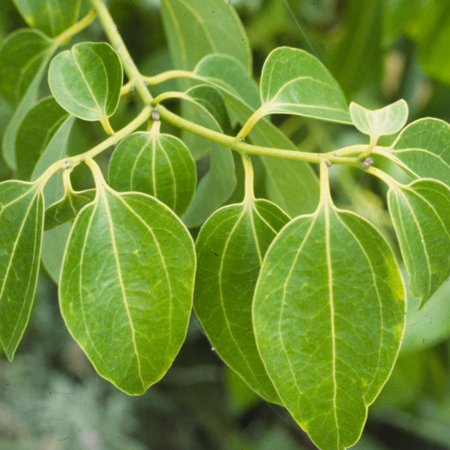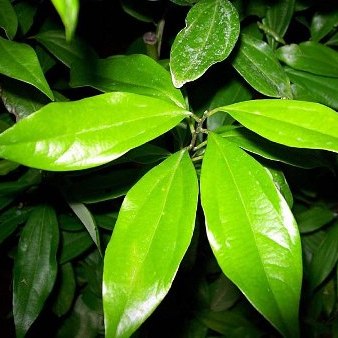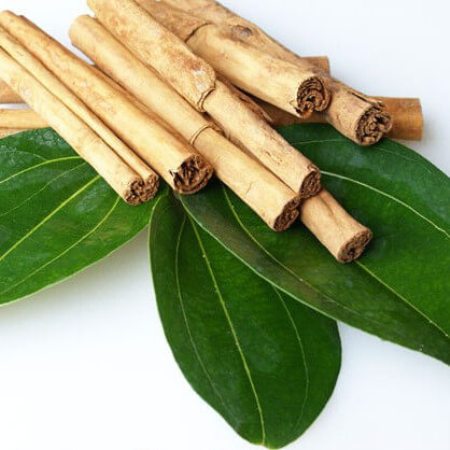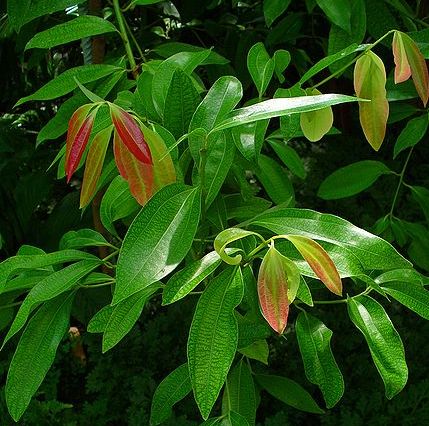




Botanical name Cinnamon zeylanicum
Family Lauraceae
Source Leaves
Origin Sri Lanka
Processing Method Steam Distillation
Color/Consistency A brownish yellow to dark liquid with a medium consistency.
Aromatic Summary / Note / Strength of Aroma A middle note of medium aroma, it has a warm, spicy scent between that of clove and cinnamon, but with herbaceous notes that are not sweet. Customers seeking the smell of the cinnamon spice should purchase Cinnamon Bark.
Blends With Clove Bud, Lavender, Cedarwood, Orange, Lemon, Neroli, Ylang Ylang, Rosemary and Thyme.
Product Abstract
Fresh Cinnamon leaves are elongated, slender, and shiny green. There is a prominent central, lighter colored vein that runs through the center of each leaf. Immature Cinnamon leaves are red in color before they mature to their bright green. Fresh Cinnamon leaves are fragrant and give off a lighter cinnamon smell and taste than cinnamon bark when used in teas or cooking. When eaten they have a hot, pungent taste. Cinnamon leaves are commonly pruned from the trees and left to dry for several days before being processed for Cinnamon leaf oil. Dried Cinnamon leaves have a matte finish and become olive in color and resemble bay leaves.
History
Cinnamon has been known from remote antiquity. It was imported to Egypt as early as 2000 BCE, but those who report it had come from China confuse it with cassia.Cinnamon was so highly prized among ancient nations that it was regarded as a gift fit for monarchs and even for a god; a fine inscription records the gift of cinnamon and cassia to the temple of Apollo at Miletus. Though its source was kept mysterious in the Mediterranean world for centuries by the middlemen who handled the spice trede, to protect their monopoly as suppliers, cinnamon is native to India, Sri Lanka, Bangladesh, and Myanmar.
Harvesting/Extraction Information
Cinnamon is an evergreen tree characterized by oval-shaped leaves, thick bark, and a berry fruit. When harvesting the spice, the bark and leaves are the primary parts of the plant used. Cinnamon is cultivated by growing the tree for two years, then coppicing it, i.e., cutting the stems at ground level. The following year, about a dozen new shoots form from the roots, replacing those that were cut. A number of pests such as Colletotrichum gloeosporioides, Diplodia spp., and Phytophthora cinnamomi can affect the growing plants.
Common Usage
Caution
Being strong in nature, cinnamon oil should be avoided for internal consumption. Furthermore, it can have adverse effects on the skin if used topically in concentrated form. Therefore, it should be used in diluted form. Before using the oil, it should be tested to make sure it suits your skin. You should apply only a small quantity of the oil initially and check if you develop any allergic reaction. Do not apply the oil on the face and other sensitive areas.
Key constituents
Eugenol 68.6–87.0%
Eugenyl acetate 1.0–8.1%
Linalool 2.0–5.0%
(E)-Cinnamyl acetate 0.8–4.6%
Benzyl benzoate tr–4.1%
b-Caryophyllene 1.9–3.7%
(E)-Cinnamaldehyde 0.6–1.1%
Safrole 0–1.0%
Cinnamyl alcohol 0–0.6%
Quality Cinnamon leaf oil may be adulterated by the addition of clove fractions, eugenol or cinnamic aldehyde.
Safety summary
Hazards Drug interaction; may inhibit blood clotting; may contain safrole; skin sensitization (moderate risk); mucous membrane irritation (low risk).
Cautions (oral) May interact with pethidine, MAOIs or SSRIs. Anticoagulant medication, major surgery, peptic ulcer, hemophilia, other bleeding disorders. Maximum adult daily oral dose: 175mg
Maximum dermal use level.
EU 1.0%
IFRA 1.0%
Tisserand & Young 5.0%
Maximum dermal use level (based on eugenol content)
EU No legal limit
IFRA 0.6%
Tisserand & Young 0.6%
Our safety advice
We recommend a dermal maximum of 0.6% based on 87% eugenol content with a limit of 0.5%.
Our oral maximum is based on 1.0% safrole, with a limit of 0.025 mg/kg/day.
Regulatory guidelines
Has GRAS status. IFRA and the EU recommend a maximum exposure level of 0.01% of safrole from the use of safrolecontaining essential oils in cosmetics. IFRA recommends a maximum dermal use level for eugenol of 0.5% for most product types, in order to avoid skin sensitization.
Organ-specific effects
Adverse skin reactions Undiluted cinnamon leaf oil was moderately irritating to mice, and strongly irritating to rabbits; tested at 10% on 25 volunteers it was neither irritating nor sensitizing. It is non-phototoxic. Contact with the skin by undiluted cinnamon oil (type unspecified) is frequently associated with a burning sensation, and occasional blistering. Undiluted cinnamon oil caused severe burns in an 11-year-old boy after remaining in contact with the skin for 48 hours, when a vial broke in his pants pocket. In a case of extensive and long-lasting dermatitis following a mud bath containing cinnamon oil, patch testing confirmed allergy to cinnamon oil in a 74-year-old woman. Several cases of occupational ACD to cinnamon oil have been reported, one of them through airborne contact.
Cardiovascular effects Eugenol inhibits platelet aggregation, an essential step in the blood clotting cascade.
Systemic effects
Comments
The safrole content of cinnamon leaf oil would mean that 1.0% or more of the oil could be used for dermal application. However, a greater restriction is in place for eugenol.